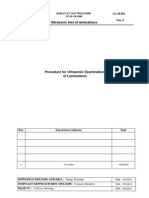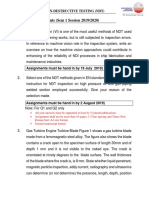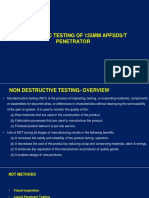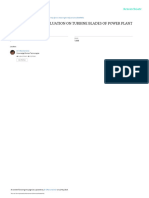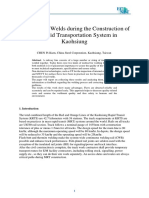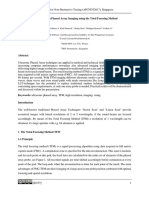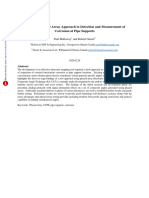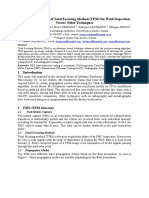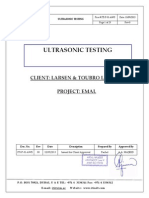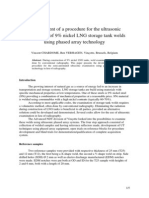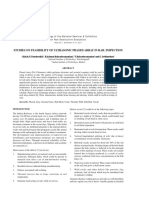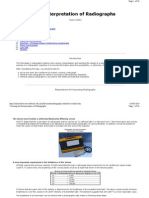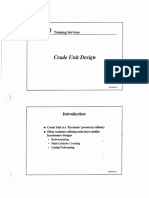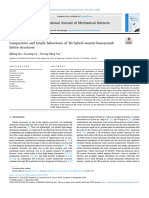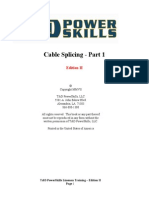MEC4801 Assignment
MEC4801 Assignment
Uploaded by
Vincent WongCopyright:
Available Formats
MEC4801 Assignment
MEC4801 Assignment
Uploaded by
Vincent WongOriginal Description:
Copyright
Available Formats
Share this document
Did you find this document useful?
Is this content inappropriate?
Copyright:
Available Formats
MEC4801 Assignment
MEC4801 Assignment
Uploaded by
Vincent WongCopyright:
Available Formats
MEC4801 Assignment
This assignment contributes 10% to the entire unit.
Individual assignment
Due date: 5pm, Monday, 4th May 2015
Submit to: Dr. Wang Xin, room 5-4-10
Q1 [25 marks]
a)
Figure 1. Gas Turbine Engine Turbine Blade
Figure 1 shows a gas turbine blade made from a ferromagnetic steel alloy. The figure also
shows the blade contains a crack open to the specimen surface of length 30mm and of depth 1
mm and it is not visible to the naked eye. The crack is orientated at ninety degrees to the
blade surface. The wall thickness of the blade where the crack is, is 8 mm. State whether
liquid penetrant, magnetic particle inspection, eddy current, radiography and ultrasonics can
determine (or not determine) the presence, length, depth, position and shape of the crack.
Describe briefly the principles of the techniques and state which technique you would choose
to determine the presence of the crack.
b) The external perimeter of the blade cross section where the crack is in part a) is 80 mm.
Write a magnetic particle inspection technique to test only all the aerofoil surfaces of the blade
giving the orientation of defects which can be detected for each magnetization procedure. Use
1.7 amps AC RMS per mm of perimeter.
Q2 [10 marks]
An aircraft fuselage skin is composed of two layers of aluminum plates, riveted together
(Figure 2). First layer thickness is 1mm, second layer thickness is 1.5mm. How would you
determine whether a crack occurred in the first or the second layer? Calculate the necessary
testing frequencies.
1/5
Given
Figure 2
Q2 [20 marks]
A specimen consists of two horizontal metal plates, each 20 mm thick, fused together with no
air gap between them. The top plate is designated A and the bottom plate B. An
ultrasonic instrument is calibrated for 0 to 100mm for shear wave testing in plate A. This
instrument is used to drive a shear wave probe, which when placed on top of plate A,
produces an angle of 45 degrees to the normal in the plate. A small spherical defect is
detected in plate B which produces a signal which appears at a range of 50 mm on the
ultrasonic screen. What is the horizontal and vertical distance of the defect from the probe
index (or emission) point? The velocity of a shear wave in plate A is 3,230 m/s and in plate
B it is 3,000 m/s.
Q3 [25 marks]
a) The total unsharpness for a radiographic technique is 0.2828 mm. The film unsharpness is
0.2 mm. Calculate a radiographic technique to test welding defects for a steel plate of
thickness, 29 mm, using an x-ray instrument of 180 KV (Kilo Volts) and requiring a film
density of 2.5. Use Figures 3 and 4.
Given:
Instrument source size=3mm
Instrument maximum tube currrent=4mA
2/5
Film to be used is MX
Figure 3 Exposure chart for Steel (Fe), MX film, sfd = 1000mm, lead screens, density = 2
3/5
Figure 4 Film curves
b) The film is scanned and Figure 5 is the scanned radiographic image for the above. Use image
processing technique to enhance the image contrast and inspect if there is any defect in the steel
plate. In the submitted assignment, please include :
(i) the Matlab code,
(ii) the image before processing and the image after processing ,
(iii) identify the defect type,
(iv) describe briefly the principles of the image processing techniques you used.
4/5
Figure 5
Q4 [20 marks]
The pipe is vulnerable to attack by internal and external corrosion, cracking, third party
damage and manufacturing flaws. Such problems can cause expensive stoppages and serious
harm to the environment and people. Therefore early detection of any damage, preventive
maintenance and condition monitoring are essential. When a pipeline is built, NDT
technicians may use visual, X-ray, magnetic particle, ultrasonic and other inspection methods
to evaluate the welds and ensure that they are of high quality. Once the pipe is buried, it is
undesirable to dig it up. Please investigate the NDT techniques which can be used to inspect a
buried pipeline and describe briefly the principles of the techniques. (If you read any
articles or books in preparing your work, you need quote sources and put some of
the reference information in the text.)
5/5
You might also like
- OI For UT of Laminations-BasicDocument8 pagesOI For UT of Laminations-Basicperogami100% (1)
- Astm D7175Document16 pagesAstm D7175jegancivil100% (1)
- Non Destructive Test (NDT)Document8 pagesNon Destructive Test (NDT)Jhean Bernadeth ChavezNo ratings yet
- In-Line Quality Control of Laser Welds of Tailored Blanks by Couplant-Free Ultrasonic InspectionDocument6 pagesIn-Line Quality Control of Laser Welds of Tailored Blanks by Couplant-Free Ultrasonic Inspectionabraham silva hernandezNo ratings yet
- Non-Destructive Testing of Continuously Cast Billets by Means of The Laser Triangulation MethodDocument8 pagesNon-Destructive Testing of Continuously Cast Billets by Means of The Laser Triangulation MethodSyed HasniNo ratings yet
- Back Up Roll UTDocument5 pagesBack Up Roll UTkinglordofato0% (1)
- Remr Technical Note Cs-Es-1.4 Nondestructive Testing Methods For Metal StructuresDocument5 pagesRemr Technical Note Cs-Es-1.4 Nondestructive Testing Methods For Metal StructuresSaurabh BobdeNo ratings yet
- MEMB453-Assignments Section 2Document2 pagesMEMB453-Assignments Section 2Sanjay Sundaralingam100% (1)
- Ultrasonic Testing of 125Mm Apfsds/T PenetratorDocument11 pagesUltrasonic Testing of 125Mm Apfsds/T PenetratorBilal AhmedNo ratings yet
- Non Destructive Evaluation On Turbine Blades of Power Plant: June 2007Document15 pagesNon Destructive Evaluation On Turbine Blades of Power Plant: June 2007t.hosseini.ddscompanyNo ratings yet
- TCVN 4395-1986Document11 pagesTCVN 4395-1986huytai8613No ratings yet
- Image Processing For Radiographic Films of Weld InspectionDocument7 pagesImage Processing For Radiographic Films of Weld InspectionMahmoud AbdullahNo ratings yet
- NDT of Rail Welds During The Construction of The Rapid Transportation System in KaohsiungDocument7 pagesNDT of Rail Welds During The Construction of The Rapid Transportation System in KaohsiungBenzhar TubieraNo ratings yet
- Assignment 8,24 25Document7 pagesAssignment 8,24 25ae7755048No ratings yet
- PAUT Inspection of Corrosion-Resitant Alloys and Dissimilat Weld MaterialsDocument20 pagesPAUT Inspection of Corrosion-Resitant Alloys and Dissimilat Weld MaterialsRupam BaruahNo ratings yet
- Ut Level Spec QB 5 (49L)Document14 pagesUt Level Spec QB 5 (49L)Kingston RivingtonNo ratings yet
- High Resolution Phased Array Imaging Using The Total Focusing Method (Kierspel Et Al - 2017)Document8 pagesHigh Resolution Phased Array Imaging Using The Total Focusing Method (Kierspel Et Al - 2017)pjhollowNo ratings yet
- Laser Removal of TiN Coatings From WC Micro-Tools and In-Process MonitoringDocument7 pagesLaser Removal of TiN Coatings From WC Micro-Tools and In-Process MonitoringmarimuthusundarNo ratings yet
- NDT UltrasonicDocument15 pagesNDT Ultrasonicromeoamu87No ratings yet
- Ultrasonic TOFD Flaw Sizing and Imaging in Thin Plates Using Embedded Signal Identification Technique (ESIT)Document6 pagesUltrasonic TOFD Flaw Sizing and Imaging in Thin Plates Using Embedded Signal Identification Technique (ESIT)Sridharan ChandranNo ratings yet
- Ultrasonic Phased Array Approach To Detection and Measurement of Corrosion at Pipe SupportsDocument10 pagesUltrasonic Phased Array Approach To Detection and Measurement of Corrosion at Pipe SupportsPetrNo ratings yet
- UT Lev II QuestionsDocument10 pagesUT Lev II QuestionsshajeerNo ratings yet
- ARAMCO考试题(79页)Document59 pagesARAMCO考试题(79页)Yanqiang GongNo ratings yet
- Ultrasonic Guided Waves Evaluation of Trials For Pipeline InspectionDocument9 pagesUltrasonic Guided Waves Evaluation of Trials For Pipeline InspectionEmily BrockNo ratings yet
- High Resolution Ultrasonic In-Line Inspection: Added Value and Special ApplicationsDocument15 pagesHigh Resolution Ultrasonic In-Line Inspection: Added Value and Special Applicationsgo88No ratings yet
- 42266-041201technology Assesment ReliabilityDocument16 pages42266-041201technology Assesment ReliabilityosbertodiazNo ratings yet
- On Qualification of TOFD Technique For Austenitic Stainless Steel Welds InspectionDocument8 pagesOn Qualification of TOFD Technique For Austenitic Stainless Steel Welds InspectionprabuNo ratings yet
- Creeping 1Document3 pagesCreeping 1Demian PereiraNo ratings yet
- 2-Sensitivity Response of TFM For Weld Inspection Vs Other Techniques (CINDE 2019) PDFDocument8 pages2-Sensitivity Response of TFM For Weld Inspection Vs Other Techniques (CINDE 2019) PDFNguyễn Văn PhúcNo ratings yet
- Comparison Slides For RCC-M & ASMEDocument42 pagesComparison Slides For RCC-M & ASMEMirza Safeer Ahmad100% (1)
- Ut Procedure AwsDocument23 pagesUt Procedure AwsKrishna Vacha82% (11)
- ASTM G 46 Evaluacion de PittingDocument8 pagesASTM G 46 Evaluacion de Pittingiolivero79641No ratings yet
- 2008 Development of A Procedure For The Ultrasonic Examination of Nickel LNG Storage Tank Welds Using Phased Array TechnologyDocument5 pages2008 Development of A Procedure For The Ultrasonic Examination of Nickel LNG Storage Tank Welds Using Phased Array Technologyநந்த குமார் சம்பத் நாகராஜன்No ratings yet
- Manual Ultrasonic Inspection of Thin Metal WeldsDocument16 pagesManual Ultrasonic Inspection of Thin Metal WeldsSimon LeeNo ratings yet
- Ecndt 0240 2018 File001Document10 pagesEcndt 0240 2018 File001Joe BuckleyNo ratings yet
- 131 Pollock Rev2Document14 pages131 Pollock Rev2jorgeNo ratings yet
- Studies On Feasibility of Ultrasonic Phased Array in Rail InspectionDocument4 pagesStudies On Feasibility of Ultrasonic Phased Array in Rail InspectionMartin Chimenti - ARO SANo ratings yet
- DefectsDocument36 pagesDefectsMaverikbjNo ratings yet
- RT Specific ExamDocument3 pagesRT Specific ExamGoutam Kumar Deb100% (3)
- Ultrasonic or MFL InspectionDocument4 pagesUltrasonic or MFL InspectionArjun Pratap Singh100% (3)
- Asme Sec VDocument7 pagesAsme Sec VjacquesmayolNo ratings yet
- API 570 To ModifyDocument6 pagesAPI 570 To Modifycisar0007No ratings yet
- UT Level II GeneralDocument10 pagesUT Level II GeneralkingstonNo ratings yet
- New Techniques For The Quantification of Defects Through Pulsed Magnetic Flux LeakageDocument6 pagesNew Techniques For The Quantification of Defects Through Pulsed Magnetic Flux LeakageRonaNo ratings yet
- A Study of Surface Roughness Variation in Ultrasonic Vibration-Assisted Milling PDFDocument9 pagesA Study of Surface Roughness Variation in Ultrasonic Vibration-Assisted Milling PDFMichal CerovskýNo ratings yet
- NDT Phased Array Ultrasonic TestingDocument54 pagesNDT Phased Array Ultrasonic TestingDeepak100% (2)
- Ultrasonics Corrosion PittingDocument11 pagesUltrasonics Corrosion PittingAsyraf NordinNo ratings yet
- Aec Q100-001CDocument14 pagesAec Q100-001CelectronarutoNo ratings yet
- Chip Evacuation of PCB Micro-Drilling and High-Speed PhotographyDocument7 pagesChip Evacuation of PCB Micro-Drilling and High-Speed PhotographyChethan GowdaNo ratings yet
- Abstract Dent and Gouge Defects Assessment A Case Study of Gas PipelineDocument10 pagesAbstract Dent and Gouge Defects Assessment A Case Study of Gas PipelineTzu Huan PengNo ratings yet
- Failure Analysis of A Vibration Isolator Used in Launch Vehicle ApplicationDocument21 pagesFailure Analysis of A Vibration Isolator Used in Launch Vehicle ApplicationPiyush PathakNo ratings yet
- Ultrasonic oDocument8 pagesUltrasonic oDiego Alfonso Godoy PerezNo ratings yet
- Code Case - 2235-10Document10 pagesCode Case - 2235-10Nilesh Pathare0% (1)
- V+ 4.magnetic Particle ExaminationDocument12 pagesV+ 4.magnetic Particle ExaminationAMAL VISHNUNo ratings yet
- Time of Flight Diffraction - An Alternative To Radiography For Examination of Thick Walled Stainless Steel WeldmentsDocument6 pagesTime of Flight Diffraction - An Alternative To Radiography For Examination of Thick Walled Stainless Steel WeldmentsKhafdi99No ratings yet
- Non-Destructive Evaluation of Corrosion and Corrosion-assisted CrackingFrom EverandNon-Destructive Evaluation of Corrosion and Corrosion-assisted CrackingNo ratings yet
- Industrial X-Ray Computed TomographyFrom EverandIndustrial X-Ray Computed TomographySimone CarmignatoNo ratings yet
- New Sensors and Processing ChainFrom EverandNew Sensors and Processing ChainJean-Hugh ThomasNo ratings yet
- Photonics, Volume 2: Nanophotonic Structures and MaterialsFrom EverandPhotonics, Volume 2: Nanophotonic Structures and MaterialsNo ratings yet
- Noise in Nanoscale Semiconductor DevicesFrom EverandNoise in Nanoscale Semiconductor DevicesTibor GrasserNo ratings yet
- Tutorial4 QuestionsDocument2 pagesTutorial4 QuestionsVincent WongNo ratings yet
- MEC3455 Tutorial 1Document3 pagesMEC3455 Tutorial 1Vincent WongNo ratings yet
- Convergence TestsDocument3 pagesConvergence TestsVincent WongNo ratings yet
- Design Desc CompoundDocument2 pagesDesign Desc CompoundVincent WongNo ratings yet
- 7.1 Dynamic Vibration AbsorberDocument9 pages7.1 Dynamic Vibration AbsorberVincent Wong100% (1)
- Decision Making: Criteria Table To Evaluate Alternative Design of Device ADocument1 pageDecision Making: Criteria Table To Evaluate Alternative Design of Device AVincent WongNo ratings yet
- DARAK For Flooded Batteries PDFDocument3 pagesDARAK For Flooded Batteries PDFJelenaNo ratings yet
- CPT Brochure 1Document12 pagesCPT Brochure 1jose antonio becerra mosqueraNo ratings yet
- Wps 7018 SmawDocument1 pageWps 7018 SmawErick VazquezNo ratings yet
- Applications of Nanotechnology in AerospaceDocument7 pagesApplications of Nanotechnology in AerospaceSmitha KollerahithluNo ratings yet
- Properties of MetalsDocument3 pagesProperties of MetalsChris Michelle Japin100% (1)
- Passive Water Intake ScreensDocument2 pagesPassive Water Intake Screenspurya89No ratings yet
- Bench Vise PDFDocument1 pageBench Vise PDFshubhamNo ratings yet
- Phillip Loldrup Fosbøl - 87-91435-89-7Document250 pagesPhillip Loldrup Fosbøl - 87-91435-89-7Cristhian CastilloNo ratings yet
- Li MXO4Document8 pagesLi MXO4Ricardo DanielNo ratings yet
- CH 07Document33 pagesCH 07Fabio OliveiraNo ratings yet
- Approved AbstractsDocument19 pagesApproved Abstractsanjaiah_19945No ratings yet
- Group Task 1Document3 pagesGroup Task 1anon_202144994100% (1)
- Katalog ARITA 20199Document68 pagesKatalog ARITA 20199Fresly JayaNo ratings yet
- Wet Preparation of Soil Samples For Particle-Size Analysis and Determination of Soil ConstantsDocument3 pagesWet Preparation of Soil Samples For Particle-Size Analysis and Determination of Soil ConstantsIngrid RomanNo ratings yet
- CBH-21-012 Stud Bolt M12 X 2000 HDG 8.8Document1 pageCBH-21-012 Stud Bolt M12 X 2000 HDG 8.8qualityNo ratings yet
- Foundations Model - pdf6Document1 pageFoundations Model - pdf6Abdo AboretaNo ratings yet
- Biocides Product GuideDocument1 pageBiocides Product GuideLuigi NicoraNo ratings yet
- 03 Crude Unit DesignDocument88 pages03 Crude Unit DesignVĂN ĐOÀN HUYNo ratings yet
- Ullmann's Encyclopedia of Industrial Chemistry-Methanol ProductionDocument22 pagesUllmann's Encyclopedia of Industrial Chemistry-Methanol ProductionabubakarNo ratings yet
- Well Heads According To Api 6aDocument5 pagesWell Heads According To Api 6aEDWIN M.PNo ratings yet
- Rencana Impor - Alas Kaki HS Code 6404 - PT Omega Fashindo AdiperkasaDocument21 pagesRencana Impor - Alas Kaki HS Code 6404 - PT Omega Fashindo AdiperkasaDede ariefNo ratings yet
- 3D Hybrid Auxetic-HoneycombDocument15 pages3D Hybrid Auxetic-Honeycombd23249No ratings yet
- Solvothermal and Hydrothermal SynthesisDocument28 pagesSolvothermal and Hydrothermal SynthesisZoubir SaidiNo ratings yet
- 1 Level:: 2.1 Material PropertiesDocument7 pages1 Level:: 2.1 Material PropertiesIstvan OrbanNo ratings yet
- The Story of HeliumDocument45 pagesThe Story of HeliumsmjjpNo ratings yet
- Food Pharma GBDocument32 pagesFood Pharma GBjosvangompelNo ratings yet
- API - 510 Exam - 5 - ClosedDocument4 pagesAPI - 510 Exam - 5 - Closedsiraj.hoteccNo ratings yet
- Cable Splicing - Part 1: Edition IIDocument0 pagesCable Splicing - Part 1: Edition IISalman FaisalNo ratings yet
- Writing and Balancing Chemical EquationsDocument4 pagesWriting and Balancing Chemical EquationsEmmarie MercadoNo ratings yet
